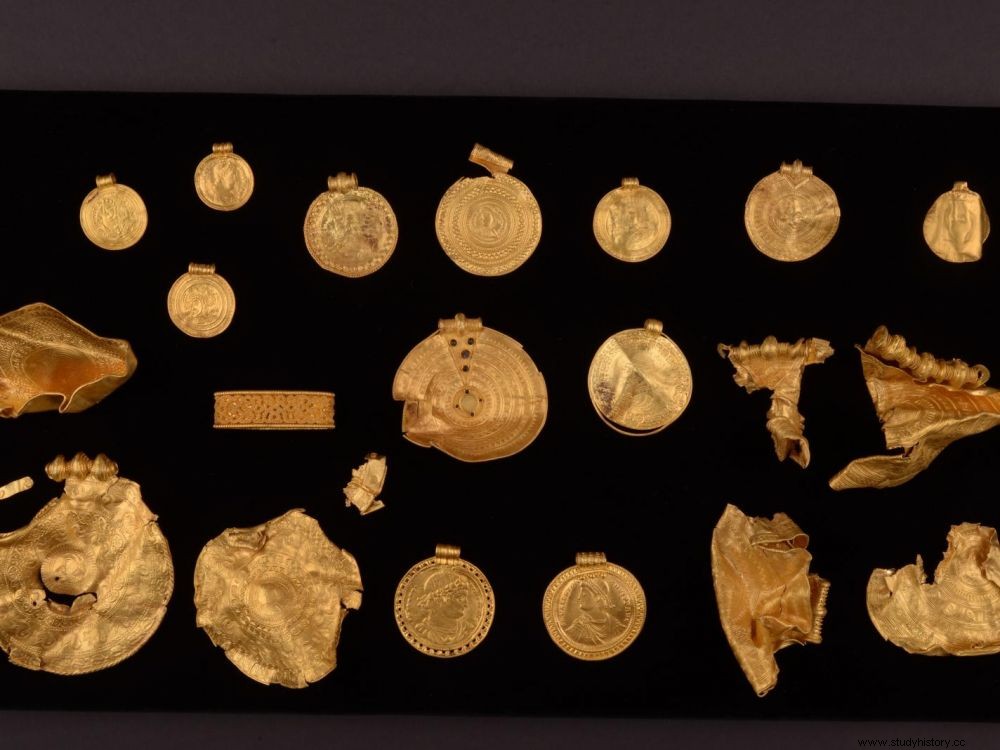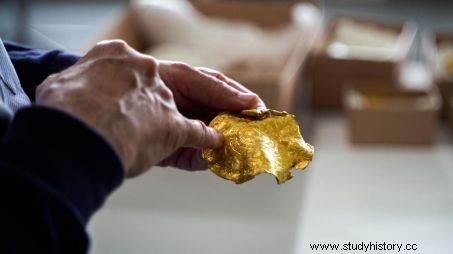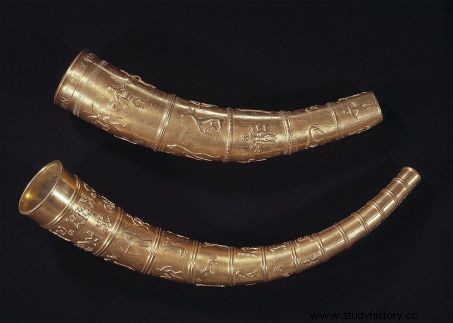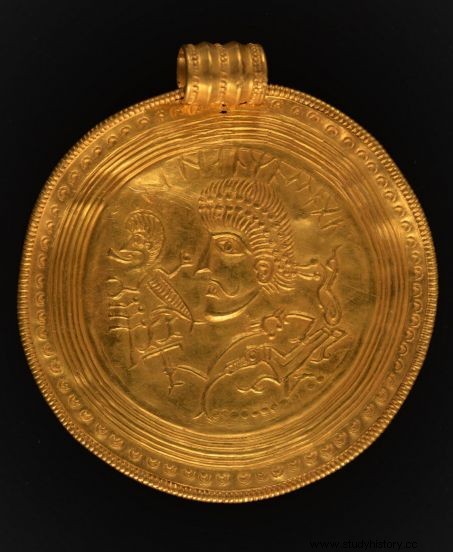The unearthing of a treasure not far from the city of Jelling, Denmark, suggests that a powerful lord lived in the Jutland peninsula in the 6 e century of our era. Among the objects found are gold bracteates bearing as yet unknown runic designs and inscriptions, which may represent early versions of characters from Norse mythology.

22 gold objects make up the Vindelev treasure, unearthed in December 2020 in Denmark.
ARCHAEOLOGY. At the end of December 2020, an amateur detectorist who had just received authorization to prospect discovered in a field located in the municipality of Vindelev, in Jutland (the mainland of Denmark), a real treasure which, according to the first examinations , could bring new elements on the history of the country. Excavations carried out in the summer of 2021 by a team of archaeologists from the Vejle Museum, in cooperation with experts from the Danish National Museum, have established that this treasure was buried around 1,500 years ago under a longhouse that is part of a village made up of 3 or 4 farms.
One of the most beautiful treasures discovered in Denmark
"It's a treasure rarely found ", says in a press release Mads Ravn, the head of research at the Archaeological Museum of Vejle, where the 22 unearthed objects are now located. They are almost exclusively gold medallions that have been transformed into jewelry, the whole weighing nearly a kilogram! a small coffee saucer; the others, ancient Roman coins. The bracteates were worn around the neck to show which partner one had made an alliance with. Their size makes them immediately exceptional, adds Mads Ravn:"Some of them fill a hand, whereas items like this are usually the size of a penny. "

The bracteates found are of exceptional size . © Konserveringscenter Vejle
The Danish archaeologists who have examined the "Vindelev treasure" all recognize its unique nature, due to the size, quality and craftsmanship of the artifacts that make it up. There is no doubt:it is one of the largest, richest and finest gold hoards in Danish history. In this it is comparable to the golden horns of Gallehus, two drinking horns dating from the 5th century, weighing in all seven kilograms, which were found in the same region in the 17th and 18th centuries. These few medallions also provide new information on the period of the late Danish Iron Age in the Jutland peninsula, which is the cradle of Denmark.

The two golden horns of Gallehus were found within yards of each other a century apart. Stolen to be melted down in the 19th century, copies were made thanks to drawings . © Nationalmuseet
Unknown runic inscriptions
For the moment, archaeologists describe with precision only one of these medallions, a magnificently decorated bracteate, decorated in its center with a motif that they did not yet know. It is a man's head with braided hair, shown in profile, surrounded by a horse and a bird. A runic inscription was struck on the gold leaf between the nostrils and the front legs of the horse. According to the researchers who deciphered it, it could be read houaʀ , which means "the most high". But doubt remains as to its interpretation:does the inscription designate a sovereign of the time, or that of the gods, since in Viking mythology, this same term is associated with the god Odin? If so, then this bracteate could represent an early version of the main god of Norse mythology.
However, this qualifier does not appear until several hundred years later, explains Lisbeth Imer, curator and researcher at the National Museum of Denmark. We know it, for example, thanks to the Icelandic poems, which date back to the 9
e
century and were transmitted in an oral form. Mads Ravn deduces that "perhaps this is a sign that as early as AD 500, or 300 years before the Viking Age, late Viking Norse mythology and thought was more prevalent than we thought ".

The bracteates are richly decorated with portraits, motifs and runic inscriptions. © Konserveringscenter Vejle
Roman coins that testify to distant exchanges
Roman coins have also been admired by archaeologists, primarily because of the techniques used to turn them into jewelry, as they have never seen anything like it. The most notable of these solid gold coins, which are almost 24 carats, features Emperor Constantine the Great (AD 285-337). According to the researchers' conclusions, the fact that she was able to find herself 300 years later in the very north of the European continent shows how the most remote regions were then closely linked by trade and war.
A center of power from the late Iron Age
The amount of gold found at the Vindelev site alone is enough to suggest that this region of Jutland must have been a center of power during the late Iron Age, ruled in the 6
e
century of our era an extremely wealthy lord, not only able to acquire these goods, but also to attract to him goldsmiths of great talent.
This discovery comes as a surprise all the more as Vindelev is less than 8 kilometers from the site of Jelling, which is considered a seat of power from the Viking Age and the cradle of the Kingdom of Denmark. Classified as a UNESCO World Heritage Site, the archaeological site of Jelling includes two rune stones, erected by the two kings who established this power in the 10
th
century:Gorm the Elder (died around 958), and his son Harald the Blue Tooth, who during his reign (between 959 and 987) is said to have "made the Danes Christian" , as the inscription that adorns its stone says. Nothing until then suggested that a warlord could have lived in roughly the same place, 400 years before the birth of the kingdom of Denmark; but as the researchers recognize that very little is known about the history of the region before the Viking period, they consider that there may indeed have been a local center of power in the centuries before the Viking era. viking. Besides, other villages dating from the same period have also been discovered in the region.
The "Little Ice Age of Late Antiquity":a chaotic period
One can also only speculate why the lord of Vindelev would have buried this treasure. He might have wanted to keep it in a safe place in order to use it at the appropriate time, in the event of war for example. But researchers are leaning towards another explanation, since most of the great discoveries of gold objects in Scandinavia date precisely from the middle of the 6 th century, which actually corresponds to a chaotic era. The burial could thus be linked to a climatic catastrophe that had a global impact:the "Little Ice Age of Late Antiquity". Indeed, around the year 536 AD, several very violent volcanic eruptions occurred, attributed to Ilopango in Central America, or Krakatoa in Southeast Asia; following these eruptions, clouds of ash and dust darkened the atmosphere so much that crops were compromised for many years, causing famine.
The "Vindelev treasure" therefore conceals many mysteries, which Danish archaeologists now intend to elucidate through the analysis of samples and data collected on the site of the discovery. They hope to find information that could explain the owner of these medallions and the circumstances of their burial. The discovery of this new treasure could then come to support the theories of some Danish researchers, who believe that the foundations of the society of the Viking Age and of a united Danish kingdom go back to this period of the Iron Age.
